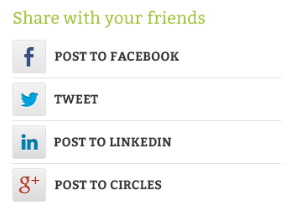Thanking and Retaining Your Monthly Donors
Your donors make your mission possible. They’re also people. Real live humans! This means they need to hear from you…like a human.
Once they set up their monthly gift, a sterile, robotic “Your donation has been processed.” will not compute. Er, I mean, it just isn’t good enough. You’ve gotta tap into the personal and emotional reasons for giving and evoke them in your follow-up communications.
Let’s work together to get in touch with our emotions and banish bot-like behavior when it comes to thanking (and keeping!) your monthly donors.
- Creating a superb thank you just for your monthly donors
- Setting up a communication track for these special supporters
- Crafting a stewardship plan that will keep you organized, and keep your monthly donors feeling the love
What to offer donors after they give
Here’s what you need to give monthly donors immediately after setting up their recurring donation online:
A confirmation and receipt.
Your confirmation page should reassure donors that their monthly gift was successfully scheduled. Make sure your donors get donation receipts that include a summary of the monthly donation details and information on tax deductibility. Your confirmation page should list this information, in addition to sending it via email.
A warm thank you.
Let’s agree on this: A receipt is not a thank you. Since we established that you’re not a robot (see above), your online donation confirmation page should feature a personal thank you message that was written by a real human. Now is the perfect time to start letting your monthly donors feel your gratitude.
Then, help your donors feel great about giving by sending them a warm, timely thank you letter. Stay in touch so that they feel like a true part of your community and keep them up to date on the impact of their donation. When donors know their contribution is appreciated and makes a difference, they’ll be happy to continue, and eventually increase their gift.
Enable and encourage social sharing.
Giving is social by nature. Make it easy for your donors to spread your message by giving them tools to share via social media. Include social sharing buttons on your donation confirmation and thank you pages, in your thank you letters, and in follow-up emails.

Enlist them as advocates.
Since monthly donors are often your best spokespeople (after all, they’re committed to your cause!), let their passion create a wave of donations by giving them a way to reach out to their friends and family by email. Provide some suggested language to help them talk about your cause and the impact donations will have. Later, you can also teach them how to set up a fundraising campaign with a peer-to-peer fundraising tool.
To do: Create a special orientation page to direct your recurring donors to after they’ve set up their monthly gift. Include ways for them to stay involved and connect with your organization.
Adopt an attitude of gratitude
When you connect with monthly donors to talk about your collective impact, approach it from a place of passion. Ask yourself why you’re involved with your cause and why you love it, then use that emotion to help you tell great stories and forge strong connections. Consider hosting a feel-good appreciation event each year to bring your gratitude to life. This could be an open house, an exhibit, a graduation, or a virtual event, such as a telephone town hall or webinar, depending on your cause.
Of course, a strong thank you letter is your golden opportunity to begin building a long-term relationship with monthly donors. Draw them in with an emotional, interesting opening. Don’t start with the typical “On behalf of our staff and board, we thank you for your recent donation.”
Boring!
Start with a vivid image or mini-story of what the donor made possible, and why their monthly support is crucial to your work.
I’m not typically a rule follower, but in the case of monthly donor appreciation, there are some absolute musts.
- KNOW YOUR DONOR: Capture information on how your donors gave and which campaign or program they are supporting. Did they become a monthly donor in response to a special appeal or at an event? Were they asked to donate by one of your board members? You need these details to properly thank and cultivate them.
- ALWAYS THANK YOUR MONTHLY DONORS: Always. No exceptions, no excuses. Also, your thank you should reflect the fact that they’re recurring donors. Underscore their special status.
- THANK THEM EARLY: You should thank your sustainers within a few days of setting up their recurring donation.
- THANK THEM OFTEN: Thank your donors several times, over time, and keep reporting back on the cumulative impact they are making.
- EXPRESS APPRECIATION: Say how pleased and thankful you were to get the donation. What did it mean to you and the people you serve? Emotion begets emotion, so don’t shy away from effusive praise. Your monthly donors definitely deserve it.
- FOCUS ON EMOTION: Tell a short, compelling story or use a specific example that shows what monthly donors make possible. Tug at the heartstrings and bring your mission to life. Some fun ideas: Take photos of your work and slip one of those pictures into a mailed card. (Yes, through the post office!) Have a beneficiary write the thank you email. (For more ideas, check out these 7 amazing examples.)
- GIVE THE DONOR CREDIT: Your communications to monthly donors (and all donors, really) should use the word “you” a lot more than you use the word “we.” Give your donors credit for what you do in every piece of outreach.
- BE SPECIFIC ABOUT IMPACT OF THE RECURRING GIFT: Make very clear how you will use the money they’ve given and tie that impact back to the campaign that prompted your monthly donor to give. If you sent an appeal to save puppies, talk about how many puppies that donor will save over the course of a year!
- MAKE IT PERSONAL: In addition to addressing the donor by name, you want to sign the thank you letter from a real person. No “dear friend” or “dear supporter” salutations and no nameless signatories! We recommend you get creative with who “signs” your electronic and mailed letters – a board member, a volunteer, or a beneficiary can add significance to your acknowledgement.
As I mentioned above, it’s important to tell monthly donors about the specific impact of their gift several times over the course of the year. This isn’t just an opportunity to keep the thank you train rolling, it’s an important reminder and report on their ongoing impact.
Remember: donors want to know their gift is being put to good use. They want to make a difference! So, your job is to make sure they know that they are doing just that.
Think about a few forms of outreach you will devote to reporting on the difference that is being made. Some ideas:
- Email newsletters
- Hand-written notes
- Videos featuring your staff and beneficiaries
- Photographs and postcards
- Appreciation events
- Annual reports
Tip: As you write your thank you letters, have a real donor in mind. Even better, keep their name and photo on your desk so you don’t slip into “robot writing” mode.
The hearty welcome
Want to bring new monthly donors even closer to your organization? Of course you do.
After they set up their gift and get the initial thank you, keep the love flowing with an email welcome series.
A welcome series is a sequence of two to three simple, personal email messages (a plus if you can automate them!) that your donor receives over the course of their first few months as a member of your program. It educates them about your organization, its programs, and ways to get involved and stay connected. If executed thoughtfully, a welcome series can help you give these VIP supporters the personal attention they need without a huge resource commitment.
Plan Your Welcome Series
Send a personal note from the voice of your organization.
This could be your organization’s executive director, a staff member who works in your development department, or a celebrity spokesperson. (Quick tip: Tread lightly with your spokesperson. Donors want to talk to someone who relates to them on an ongoing basis, not just a talking head.) Your first email should focus on educating your monthly donors and reminding them of their special status as part of your recurring giving community. Reinforce benefits and set expectations about what your supporters will receive and how often.
Highlight specific ways your monthly donors can stay involved and informed.
Do you have new programs geared toward families? Are you looking for volunteers for your homeless ministry? Planning a gala dinner and recruiting committee members? In your second welcome message, emphasize sharing ways to get involved or highlight the value of being a monthly supporter. Mentioning upcoming events will also give new donors a chance to meet your staff in person and will likely increase their level of involvement with your organization.
Provide other ways to engage with your organization.
Tell them about how they can connect with your staff through Facebook or Twitter. Do you post compelling videos that are super sharable? Include a link to your YouTube channel.
Timing
Your first welcome message should come promptly after your initial thank you message. That being said, you know your audience best, so experiment with the number of days or even weeks that elapse between your messages. Some organizations find that sending one message every 2 weeks for 6 weeks is effective, while others prefer weekly messages.
Tracking
Monitor your organization’s click-through and open rates and adjust your approach based on your results. Don’t be afraid to change the frequency of your messages as well as your subject lines, content, and calls to action. We advocate testing different versions of each email to find what works best for your unique message and subscribers.
Mobile
As of January 2015, 53% of email opens are happening via mobile devices. This means your emails must be easy to read on a smartphone and that you are pointing to mobile-friendly pages. An easy way to make your email more smartphone-friendly is to keep it simple, short, and optimized for fingertip navigation. Can someone easily click on your link or button with their thumb? If not, rethink your email design. Your desktop readers will thank you, too.
Tip: What are the three most important things you want new monthly supporters to know? Make sure these ideas are donor-centric ideas, then plan your first few messages around these topics.
The master plan for monthly donor nirvana
To keep your monthly giving program going strong, you’ll need a process for developing a relationship with your monthly donors. Think about the three P’s:
People: Identify who will be in charge of thanking monthly donors and have that person commit to the goals you have set. This may be the same person who handles donor relations for all types of supporters, or you may have someone who is focused on your monthly giving program from start to finish.
Process: Have that person write up a formal business process for your monthly donors (both through your nonprofit’s donation page and from online giving sites, like NetworkforGood.org, GuideStar, and others), direct mail, and phone.
Perfection: Put in place a monitoring system or quality control process, so you can spot check that your monthly donors are thanked properly and on time.
As you think about your donor stewardship plan, ask yourself these key questions:
- Who is primarily responsible for donor communication and donor retention?
- How will you thank monthly donors after they set up their recurring gift?
- How often do you plan to update donors on the impact of their gift?
- What is your policy on timing before asking recurring donors to increase their monthly support?
- Will you have any special programs or events that are exclusive to monthly donors?
- Do different levels of monthly giving get special treatment or acknowledgment?
- How do you plan to gather feedback from your monthly donors?
- How will you track and report on retention for your monthly giving program?
- How will you follow up on donor credit card failures and expirations?
We’re almost done! You now have a great thank you, a communication series, and a plan. The next step is to put everything on a calendar. Be sure to include:
- The dates you’ll complete your goals, plan, and budget
- Dates for regular outreach to sustaining donors
- Dates for recognition programs
- Dates for events
- Time to focus on collecting donor feedback
Tip: Create a donor retention plan that reflects your organization’s personality and values. For more tips, download our Donor Stewardship Checklist.
Key Takeaways:
-
- Make your thank yous specific and unique to reflect recurring donors’ special status in your organization’s work.
- Consider a dedicated communication track for your monthly donor segment.
- Create a donor stewardship plan to help keep your monthly donors informed and happy.




